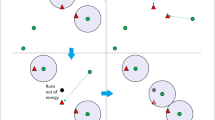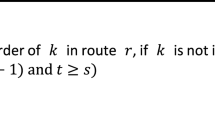Abstract
A fundamental problem that confronts wireless networks are localization, mobility maintenance and number of neighbors required to maintain the connectivity. To overcome this problem and achieve a better quality of service, a self stability model is introduced, named as localized tree model which includes min and max routing methods. This work is based on node degree, neighbor’s information and coverage area. Based on the mobility requirements of the network, dynamic structures are formed with minimum control load and complexity. Main objective of the research is to obtain the network parameters from the connectivity analysis. The performance of the proposed approach is witnessed by analyzing the parameters like scalability, packet delivery ratio and connectivity efficiency.









Similar content being viewed by others
References
Li, J., Blake, C., De Couto, D. S. J., Lee, H. I., & Morris, R. (2001). Capacity of Ad Hoc wireless networks. In Proceedings of the 7th annual international conference on mobile computing and networking, pp. 61–69.
Gupta, P., & Kumar, P. (2000). The capacity of wireless networks. IEEE Transactions on Information Theory, 46, 388–404.
Shu, L., Zhang, Y., Yang, L. T., Wang, Y., Hauswirth, M., & Xiong, N. (2010). TPGF: Geographic routing in wireless multimedia sensor networks. Telecommunication Systems, 44(1–2), 79–95.
Karp, B., & Kung, H. T. (2000). GPSR: Greedy perimeter stateless routing for wireless networks. In Proceedings of ACM Mobicom, pp. 243–254.
Liu, J., Reich, J., Cheung, E., & Zhao, F. (2004). Distributed group management in sensor networks: Algorithms and applications to localization and tracking. Telecommunication Systems, 26(2–4), 235–251.
Liu, C., Wu, K., Xiao, Y., & Sun, B. (2006). Random coverage with guaranteed connectivity: Joint scheduling for wireless sensor networks. IEEE Transactions on Parallel and Distributed Systems, 17(6), 562–575.
Ni, J., & Chandler, S. (1994). Connectivity properties of a random radio network. In Proceedings of the IEE—communications (Vol. 141, pp. 289–296), August 1994.
Yi, C., & Wang, W. (2010). On the connectivity analysis over large-scale hybrid wireless networks. In Proceedings of the 29th conference on information communications, pp. 2748–2756, March 14–19, 2010.
Xue, F., & Kumar, P. R. (2006). On the coverage and connectivity of large random networks. IEEE/ACM Transactions on Networking (TON), 14(SI), 2289–2299. doi:10.1109/TIT.2006.874384.
Xue, F., & Kumar, P. R. (2004). The number of neighbors needed for connectivity of wireless networks. Wireless Networks, 10(2), 169–181.
Nocetti, F. G., Gonzalez, J. S., & Stojmenovic, I. (2003). Connectivity based \(k\)-hop clustering in wireless networks. Telecommunication Systems, 22(1–4), 205–220.
Boegsted, M., Rasmussen, J. G., & Schwefel, H. P. (2011). Connectivity analysis of one-dimensional ad-hoc networks. Wireless Networks, 17(1), 87–101.
Hellbrück, H., & Fischer, S. (2004). MINE and MILE: Improving connectivity In mobile ad-hoc networks. ACM SIGMOBILE Mobile Computing and Communications Review, 8(4), 19–36.
Panichpapiboon, S., Ferrari, G., & Tonguz, O. K. (2010). Connectivity of ad hoc wireless networks: An alternative to graph-theoretic approaches. Wireless Networks, 16(3), 793–811.
Yousefi, S., Altman, E., El-Azouzi, R., & Fathy, M. (2008). Improving connectivity in vehicular ad hoc networks: An analytical study. Computer Communications, 31(9), 1653–1659.
Raghavan, U. N., & Kumara, S. R. T. (2007). Decentralized topology control algorithms for connectivity of distributed wireless sensor networks. International Journal of Sensor Networks, 2(3/4), 201–210.
Santi, P. (2005). Topology control in wireless ad hoc and sensor networks. ACM Computing Surveys (CSUR), 37(2), 164–194.
Bachrach, J., Nagpal, R., Salib, M., & Shrobe, H. (2004). Experimental results for and theoretical analysis of a self-organizing global coordinate system for ad hoc sensor networks. Telecommunication Systems, 26(2–4), 213–233.
Sterbenz, J. P. G., Çetinkaya, E. K., Hameed, M. A., Jabbar, A., Qian, S., & Rohrer, J. P. (2011). Evaluation of network resilience, survivability, and disruption tolerance: Analysis, topology generation, simulation, and experimentation (invited paper). Telecommunication Systems. doi:10.1007/s11235-011-9573-6 (published online on December 7, 2011).
Dressler, F. (2008). A study of self-organization mechanisms in ad hoc and sensor networks. Computer Communications, 31(13), 3018–3029.
Du, S., Khan, A., PalChaudhuri, S., Post, A., Saha, A. K., Druschel, P., et al. (2008). Safari: A self-organizing, hierarchical architecture for scalable ad hoc networking. Ad Hoc Networks, 6, 485–507.
Misra, R. (2009). On self-stabilization of multi point relays for connected dominating set in adhoc networks. In TENCON 2009—IEEE tegion 10 conference, pp 1–6.
Amouris, K., Papavassiliou, S., & Li, M. (1999). A position-based multi-zone routing protocol for wide area mobile ad-hoc networks. In Proceedings of IEEE vehicular technology conference (VTC ’99), Houston, TX, USA (Vol. 2, pp. 1365–1369).
Mauve, M., Widmer, J., & Hartenstein, H. (2001). A survey on position based routing in mobile ad-hoc networks. IEEE Network Magazine, 15(6), 30–39.
Papapostolou, A., Friderikos, V., Yahiya, T. A., & Chaouchi, H. (2011). Path selection algorithms for fault tolerance in wireless mesh networks. Telecommunication Systems. doi:10.1007/s11235-011-9497-1 (published online on June 16, 2011).
Bechler, M., Ritter, H., & Schiller, J. H. (2001). Quality of service in mobile and wireless networks: The need for proactive and adaptive applications. Telecommunication Systems, 18(1–3), 227–242.
Sánchez, D. D., López, A. M., Mendoza, F. A., Vázquez, C. C., & García-Rubio, C. (2007). Context awareness in network selection for dynamic environments. Telecommunication Systems, 36(1–3), 49–60.
Yu, C. W. (2009). Computing sub graph probability of random geometric graphs with applications in quantitative analysis of ad hoc networks. IEEE Journal on Selected Areas in Communications, 27(7), 1056–1065.
Conti, M., & Giordano, S. (2007). Multihop adhoc networking: The theory, Issue on “Ad hoc and sensor networks”. IEEE Communication Magazine, 45(4), 78–86.
Woeginger, G. J. (2003). Exact algorithms for NP-hard problems: A survey. Springer, LNCS (Vol. 2570, pp. 185–207).
Bondey, J. A., & Moorthy, U. S. R. (1976). Graph theory with applications (5th ed.). New York: Macmillan Press.
Min, M., Wang, F., Du, D.-Z., & Pardalos, P. M. (2004). A reliable virtual backbone scheme in mobile ad-hoc networks. In Proceedings of the 1st IEEE international conference on mobile ad hoc and sensor systems (MASS), pp. 60–69.
Matthews, M., & Meghanathan, N. (2010). Probability of connectivity in a grid network of wireless nodes. Review of Business and Technology Research, 3(1), 1–9.
Acknowledgments
The authors would like to thank the Management of Karunya University for sponsoring the initial stage of this work to appear in the international conferences. Grant file no: KU/REG/HR-3/1696/2011.
Author information
Authors and Affiliations
Corresponding author
Rights and permissions
About this article
Cite this article
Raj, J.S., Harikumar, R. A Localized Computing Approach for Connectivity Improvement Analysis in Wireless Personal Networks. Wireless Pers Commun 72, 2867–2883 (2013). https://doi.org/10.1007/s11277-013-1185-x
Published:
Issue Date:
DOI: https://doi.org/10.1007/s11277-013-1185-x




